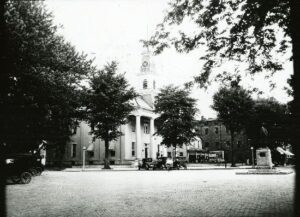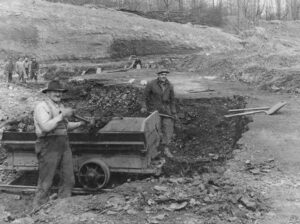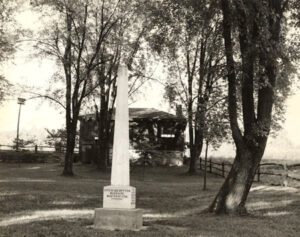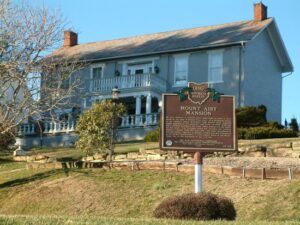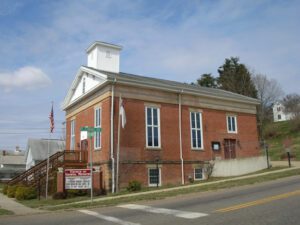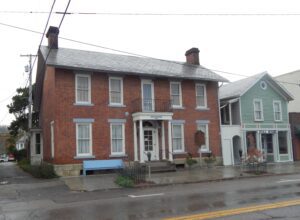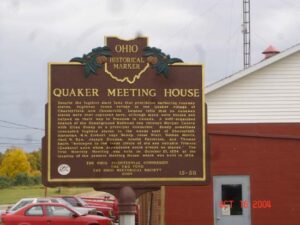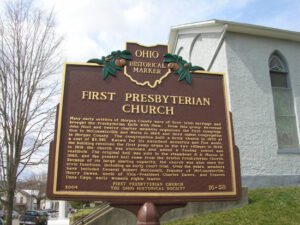, OH
Morgan County was created in 1817 from parts of Washington, Muskingum, and Guernsey counties, with McConnelsville established as the seat of government. The first courthouse, a square brick structure, was built here in 1820. Its foundation stones form part of the wall surrounding the lawn. The present courthouse building was completed in 1858 at a cost of $10,000. This Greek Revival-style structure has had several major renovations since. The clock tower was added in 1886, and the building was enlarged and modernized in 1960.
, OH
Agriculture dominated the economy of southeastern Ohio’s Morgan County until the 1940s when harvests dwindled, the population declined, and land values dropped. Surface mining the area’s rich underground coal deposits replaced agriculture as the major industry and revitalized the declining local economy. As the nation’s demand for electricity grew over the next half-century, so did the demand for coal as fuel for nearby power generation plants. During mining’s heyday in the 1960s to the late 1980s, American Electric Power’s former Central Ohio Coal Company subsidiary employed nearly 1,000 people. Nearby communities-such as Cumberland, Caldwell and Chandlersville-thrived. As time passed, however, the robust coal industry was hit hard by environmental regulations that reduced the market for the area’s high-sulfur coal. In turn, mine work forces shrank considerably and local businesses closed. (continued on other side)
, OH
Following the American Revolution, the new Federal government, in need of operating funds, sold millions of acres of western lands to land companies. One such company, the Ohio Company of Associates, brought settlement to Marietta in 1788. Two years later, despite warnings of Native American hostility, an association of 36 Company members moved north from Marietta to settle “Big Bottom,” a large area of level land on the east side of the Muskingum River. The settlers were acquainted with Native American warfare, but even so, built an unprotected outpost. They did not complete the blockhouse, put pickets around it, or post a sentry. On January 2, 1791, a war party of 25 Delaware and Wyandot Indians from the north attacked the unsuspecting settlers, killing nine men, one woman, and two children. War raged throughout the Ohio Country until August 1794 when the tribes were defeated at the Battle of Fallen Timbers.
, OH
One of Ohio’s earliest proponents of women’s rights, Frances Dana Gage (1808-1884) was born in Marietta and married McConnelsville attorney James L. Gage in 1829. She immersed herself in the major social issues of the day – temperance, abolition, and universal suffrage – while raising eight children. At a women’s rights convention in 1850, Gage gained national attention by proposing that the words “white” and “men” be removed from Ohio’s constitution. She later served as the editor of an Ohio agricultural journal, as an educator for newly emancipated African Americans, and wrote children’s tales under the pen name “Aunt Fanny.” An enormously influential woman, Gage led the way for Ohio’s next generation of social activists.
, OH
This former Universalist Church, which held a strong conviction for education and the pursuit of knowledge, was built in 1852 at a cost of $3,500. In 1865, its members decorated the first Christmas tree to be placed in a church in McConnelsville. Two years later they installed a pipe organ at a cost of $1,000, the first such organ in the community. The first Sunday School Library was also added, allowing members to borrow books and return them a week later. A number of prominent local families attended the church, including the Manly, Whitiker, Beckett, Arrick, and Murray families from the 1850s through the early twentieth century. Richard Bilbe, a former slave who had been freed, served as an early trustee of the church and attended with his family. The church was restored and reopened as a non-denominational church in 1997.
, OH
This brick, Federal-style house was built in 1836. Helen Moore, the grand daughter of General Robert McConnel, officer during the War of 1812 and founder of McConnelsville, married Dr. Hiram L. True and made their home here. Dr. True practiced medicine in the area and was widely known for his interest in science, serving as president of the local Scientific Society. Their daughter Evelyn True Button was born in the house in 1875. A graduate of Ohio Wesleyan University, Evelyn traveled to the Philippines in 1898 on a missionary trip to train teachers. A teacher, principal, community leader, and ardent worker for women’s rights, she died in the place of her birth in 1975. She bequeathed the house to the Morgan County Historical Society to serve as a depository of furnishings and artifacts of Morgan County heritage.
, OH
Despite the fugitive slave laws that prohibited harboring runaway slaves, fugitives found refuge in the Quaker village of Chesterfield, now Chesterhill. Legend tells that no runaway slaves were ever captured here, although many were hidden and helped on their way to freedom in Canada. A well-organized branch of the Underground Railroad ran through Morgan County with Elias Bundy as a principal conductor. Bundy sometimes concealed fugitive slaves in the woods east of Chester Hill. Historian W.H. Siebert says Bundy, Jesse Hiatt, Nathan Morris, Abel W. Bye, Joseph Doudna, Arnold Patterson, and Thomas Smith “belonged to the inner circle of old and reliable Friends [Quakers] upon whom dependence could always be placed.” The first Monthly Meeting was held on October 21, 1839 at the location of the present Meeting House, which was built in 1834.
, OH
Many early settlers of Morgan County were of Scot-Irish heritage and brought the Presbyterian faith with them. From this group Reverend John Hunt and twelve charter members organized the first congregation in McConnelsville and Malta in 1824 and third oldest congregation in Morgan County. The congregation built a brick church in 1832 at a cost of $2,361. Known for its excellent acoustics and fine music, the building received the first pump organ in the two villages in 1849. In 1916 the church was stuccoed and added a Sunday school and vestibule. The original bell was sold to the steamboat H.D. Munson in 1865, and the present bell came from the Bristol Presbyterian Church. Because of its large seating capacity, the church was also used for civic functions, including an early court trial. Over the years, members have included General Robert McConnell, founder of McConnelsville, Henry Dawes, uncle of Vice-President Charles Dawes, and Frances Dana Gage, early women’s rights leader.


